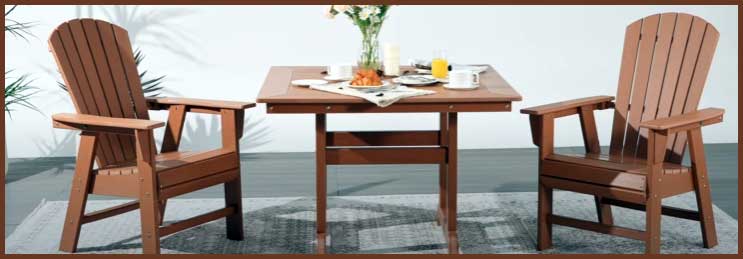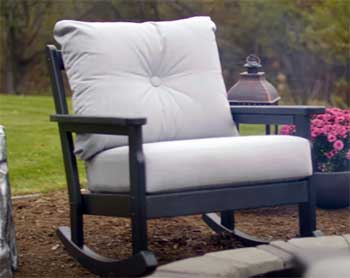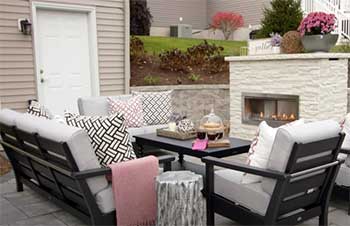I’ve always loved spending time outdoors, whether it’s sipping coffee on my patio or hosting a barbecue with friends. But finding furniture that can withstand the elements while looking stylish and staying eco-friendly?
That’s a challenge. In my quest for the perfect outdoor setup, I came across Costaelm and POLYWOOD, two brands that promise durability and sustainability. This article compares their key features, pros, and cons, helping you decide which fits your outdoor vibe.
From material quality to design options, I’ll share my insights to guide your choice.
A Brief Comparison Table
| Feature | Costaelm | POLYWOOD |
| Material | Recycled HDPE plastic | Recycled HDPE plastic |
| Wood Fibers | Yes, blended with plastic | No wood fibers |
| Weight | Lighter, easier to move | Heavier, denser construction |
| Design Styles | Modern, minimalist, vibrant colors | Classic, traditional, neutral tones |
| Durability | Weather-resistant, less fade-proof | Highly durable, fade-resistant |
| Maintenance | Low, occasional cleaning | Very low, minimal cleaning |
| Price Range | Budget-friendly to mid-range | Mid-range to premium |
| Warranty | 10-15 years | 20 years |
| Eco-Friendliness | High, uses recycled materials | Very high, recycles 400,000 milk jugs daily |
| Customization Options | Moderate, some color and cushion choices | Extensive, multiple styles and colors |
My Outdoor Furniture Dilemma
Picture this: I’m redesigning my backyard for summer gatherings, but my old wooden furniture is splintering, fading, and honestly, a bit of an eyesore. I want something that looks good, lasts through rain and sun, and doesn’t harm the planet.
After some research, I narrowed it down to Costaelm and POLYWOOD, two brands that kept popping up in my searches for sustainable outdoor furniture. Both use recycled materials, but they’re not identical.
I wanted to understand what sets them apart, so I dug into their features, tested a few pieces, and even chatted with other users to get the full picture.
Key Differences Between Costaelm And POLYWOOD
- Understanding the Materials

Let’s start with what these brands are made of, because that’s the foundation of their appeal. Costaelm uses a composite material, blending recycled high-density polyethylene (HDPE) plastic with wood fibers.
This mix gives their furniture a wood-like texture that feels warm and natural. When I sat on a Costaelm Adirondack chair, it had a slight give, almost like real wood, but without the risk of splinters. The wood fibers make it lighter than pure plastic, which I appreciated when rearranging my patio setup.
POLYWOOD, on the other hand, sticks to pure HDPE plastic, sourced from recycled milk jugs and detergent bottles. Their CEO claims they recycle about 400,000 milk jugs daily, which is impressive.
This plastic-only approach makes POLYWOOD furniture denser and heavier. I noticed this when I tried moving a POLYWOOD dining table—it’s sturdy but requires some muscle. The lack of wood fibers means it doesn’t mimic wood as closely as Costaelm, but it’s incredibly smooth and polished.
- Durability: Facing the Elements
Living in a place with unpredictable weather—think scorching summers and rainy springs—I needed furniture that could handle it all. Both brands are weather-resistant, but they perform differently. Costaelm’s composite material holds up well against rain and humidity.
I left a Costaelm bench outside during a week of storms, and it came through unscathed, no warping or cracking. However, I noticed slight fading on a bright red chair after a few months of direct sunlight, which was a bit disappointing.
POLYWOOD’s pure HDPE formula is a durability champ. Their furniture resists fading, chipping, and cracking better than most. I tested a POLYWOOD rocking chair through a brutal summer, and its navy blue color stayed vibrant.
The density of the material also makes it less prone to scratches. However, that heft can be a drawback if you’re placing furniture on a delicate surface like a wooden deck. I had to double-check my deck’s support beams to ensure they could handle the weight.
- Design and Style: Finding Your Aesthetic
Style matters when you’re creating an outdoor space that reflects your personality. Costaelm leans toward modern, minimalist designs with a pop of color. Their chairs and tables have clean lines and come in vibrant hues like turquoise and coral.
I bought a Costaelm lounge chair in light green, and it instantly became the focal point of my patio. It’s sleek, contemporary, and feels like it belongs in a trendy rooftop bar. However, their style range is narrower, so if you’re into classic or ornate designs, you might feel limited.
POLYWOOD, by contrast, excels in classic and traditional styles. Their Adirondack chairs, with wide armrests and sloped backs, scream timeless comfort. They also offer modern options like the PW Designer Series, which includes sleek pieces like the Latitude Lounge Chair.
POLYWOOD’s color palette is more neutral—think teak, mahogany, or slate gray—but they do have some brighter options. I found their Chippendale-inspired dining set elegant, perfect for a formal garden party. Their extensive range means you’re more likely to find a style that matches your vision.
- Maintenance: Keeping It Easy

I’m not one for high-maintenance furniture. Life’s busy enough without scrubbing patio chairs every weekend.
Both Costaelm and POLYWOOD are low-maintenance, which is a huge plus.
Costaelm furniture requires occasional cleaning with soap and water.
I hosed down my Costaelm bench after a dusty windstorm, and it looked brand new.
However, in humid climates, the wood fibers can attract mildew if not stored properly during extreme weather.
POLYWOOD takes low-maintenance to another level. Because it’s pure plastic, it’s less likely to harbor mold or mildew. I cleaned a POLYWOOD table with a damp cloth, and it was spotless in minutes.
They recommend storing furniture in a dry place during harsh winters, but I left mine out for a season with no issues. If you’re looking for something you can practically ignore, POLYWOOD has a slight edge.
- Price and Value: Budget Considerations
Let’s talk money, because outdoor furniture isn’t cheap. Costaelm is generally more budget-friendly, with prices ranging from $200 for a chair to $1,000 for a full dining set. I snagged a Costaelm Adirondack chair for $250, which felt like a steal for its quality.
It’s a great option if you’re starting small or working with a tighter budget. However, the shorter warranty (10-15 years) made me wonder about long-term value.
POLYWOOD’s prices are higher, often starting at $300 for a single chair and going up to $2,000 for a conversation set. Their premium pieces, like the PW Designer Series, can get pricey.
I considered a POLYWOOD dining set but hesitated at the $1,500 price tag. That said, their 20-year warranty gave me confidence in its longevity. If you’re investing for the long haul, POLYWOOD’s durability might justify the cost.
- Eco-Friendliness: Green Living
Sustainability is a big deal for me. I want furniture that doesn’t add to the planet’s problems. Both brands shine here, but in different ways. Costaelm’s use of recycled HDPE and wood fibers reduces plastic waste while incorporating natural elements.
I felt good knowing my Costaelm bench was made from materials that would’ve ended up in a landfill. However, the wood fibers might raise questions about sourcing, though Costaelm claims they use sustainable practices.
POLYWOOD’s eco-credentials are hard to beat. Their process of recycling 400,000 milk jugs daily is a massive win for the environment. They also recycle over 90% of their manufacturing scrap, which shows serious commitment.
When I learned about their closed-loop system, I was impressed—it’s like they’ve built a mini-ecosystem for furniture production. If going green is your top priority, POLYWOOD’s approach might resonate more.
- Customization: Making It Yours
I love personalizing my space, so customization options were a big factor. Costaelm offers moderate flexibility, with a decent range of colors and some cushion choices. I customized my Costaelm lounge chair with a gray cushion, which added comfort and style.
But their options feel limited compared to competitors with more fabric or finish choices.
POLYWOOD goes all out on customization. They offer a wide range of colors, from classic neutrals to bold reds, and multiple cushion fabrics. I saw a POLYWOOD conversation set with customizable Sunbrella cushions, which looked luxurious.
Their website even lets you mix and match pieces to create your ideal set. If you’re someone who loves tailoring every detail, POLYWOOD gives you more room to play.
- Comfort and Functionality
Comfort is non-negotiable when you’re lounging outdoors. Costaelm’s composite material feels softer and more natural due to the wood fibers. I spent an afternoon reading on their Adirondack chair, and the ergonomic design was a dream.
However, the lighter weight means it can feel less sturdy during windy days, so I had to anchor it.
POLYWOOD’s denser construction feels rock-solid. Their rocking chair was a hit at my barbecue—friends couldn’t stop raving about its smooth motion and sturdy feel. But the plastic can feel harder, so cushions are a must for long-term comfort.
Both brands offer functional designs, like wide armrests for drinks, but POLYWOOD’s heavier build gives it a more grounded presence.
- Warranty and Customer Support
A good warranty can make or break a purchase. Costaelm offers a 10-15 year warranty, depending on the product. When I had a question about fading on my chair, their customer service was responsive, offering tips on cleaning and maintenance.
However, the shorter warranty period made me question its long-term reliability.
POLYWOOD’s 20-year warranty is a standout. It covers defects and fading, which gave me peace of mind. I contacted their support team about a scratched table, and they were quick to send a repair kit.
Their reputation for quality service aligns with their premium branding, making them a safer bet for long-term investment.
Pros And Cons of Costaelm

Pros
- Affordable Pricing: Costaelm’s lower price point makes it accessible for budget-conscious buyers like me. I could furnish my patio without breaking the bank.
- Modern Aesthetic: The sleek, colorful designs add a trendy vibe to any outdoor space. My green lounge chair is a conversation starter.
- Lightweight: The composite material is easy to move, which I found handy when rearranging my backyard for parties.
- Eco-Friendly: Using recycled HDPE and wood fibers aligns with my sustainability goals.
- Comfortable Texture: The wood-plastic blend feels natural and inviting, perfect for long lounging sessions.
Cons
- Fading Issues: Prolonged sun exposure can cause colors to fade, as I noticed with my red chair after a few months.
- Limited Design Range: If you prefer classic or ornate styles, Costaelm’s modern focus might not suit you.
- Shorter Warranty: The 10-15 year warranty feels less reassuring compared to competitors.
- Mildew Risk: In humid climates, the wood fibers can attract mildew if not properly stored.
- Less Customization: Fewer color and cushion options limit personalization.
Pros And Cons of POLYWOOD
Pros
- Exceptional Durability: POLYWOOD’s fade-resistant, weather-proof furniture held up through my toughest weather tests.
- Eco-Friendly Champion: Recycling 400,000 milk jugs daily and minimizing waste is a huge environmental win.
- Wide Style Range: From classic Adirondack chairs to modern lounge sets, there’s something for every taste.
- Long Warranty: The 20-year warranty offers peace of mind for a long-term investment.
- Low Maintenance: Cleaning is a breeze, and it resists mold and mildew better than composites.
Cons
- Higher Cost: Premium pricing can be a stretch for budget shoppers like me.
- Heavy Weight: The dense material makes moving furniture a workout, which was tricky on my deck.
- Harder Feel: The plastic can feel less comfortable without cushions, unlike Costaelm’s softer texture.
- Neutral Color Bias: While they offer bright colors, the palette leans heavily toward classic tones.
- Complex Assembly: Some pieces, like my dining set, required more assembly time than expected.
My Real-World Experience
To get a true sense of these brands, I tested a few pieces from each. My Costaelm Adirondack chair was a breeze to set up and felt lightweight yet sturdy. Its vibrant color popped against my patio’s neutral tones, but I noticed some fading after a summer of intense sun.
The POLYWOOD rocking chair, meanwhile, was a beast to move but felt like it could survive anything. Its classic design fit my traditional garden area, and the color stayed true even after months outside. Both brands delivered on comfort, but POLYWOOD’s heft gave it a premium feel.
I also spoke with friends who own these brands. One friend raved about her POLYWOOD dining set, saying it’s been maintenance-free for years.
Another mentioned her Costaelm bench was perfect for her small balcony due to its lighter weight but needed regular cleaning in her humid climate. These real-world insights helped me see how each brand fits different lifestyles.
Making The Choice: What’s Right For You?

Choosing between Costaelm and POLYWOOD depends on your priorities.
If you’re like me, balancing budget and style, Costaelm’s affordability and modern designs are hard to beat.
It’s perfect for smaller spaces or if you love rearranging your setup.
But if durability and eco-friendliness are your top concerns, POLYWOOD’s superior fade resistance and recycling prowess make it a standout. Its classic styles and extensive customization options are ideal if you want a timeless, tailored look.
I ended up mixing both brands in my backyard. The Costaelm lounge chair adds a modern pop, while the POLYWOOD rocking chair anchors my traditional corner.
This combo works for my eclectic taste, but you might prefer one brand over the other based on your needs. Think about your climate, design preferences, and budget before deciding.
Frequently Asked Questions (FAQ)
POLYWOOD furniture is heavier, making it harder to move, and its higher price can strain budgets. The plastic feel may be less comfortable without cushions, and assembly can be time-consuming.
POLYWOOD often edges out Trex due to its pure HDPE construction and 20-year warranty. Trex, with its wood-plastic composite, is lighter but has a more limited style range.
POLYWOOD uses pure recycled HDPE plastic with no wood fibers, offering superior durability and fade resistance. Composite furniture, like Costaelm, blends HDPE with wood fibers for a lighter, wood-like feel but may be less fade-proof.
Conclusion: Your Outdoor Oasis Awaits
As I sit on my patio, sipping coffee and admiring my mix of Costaelm and POLYWOOD furniture, I’m reminded how personal this choice is. Costaelm’s affordability and modern flair make it a great pick if you’re starting out or love vibrant designs.
POLYWOOD’s durability and eco-friendly edge are perfect if you’re investing for the long haul. Use my insights to weigh what matters most—budget, style, or sustainability—and create an outdoor space you’ll love.
Your perfect patio is just a decision away.
